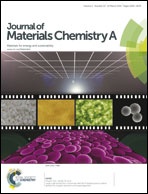Energy and charge transfer by donor–acceptor pairs confined in a metal–organic framework: a spectroscopic and computational investigation†
Abstract
Molecular organization of donor–acceptor pairs within a metal–organic framework (MOF) offers a new approach to improving energy and charge transfer at donor–acceptor interfaces. Here, the photo-physical effects of infiltrating MOF-177 (ZnO4(BTB)2; BTB = 1,3,5-benzenetribenzoate) with α,ω-dihexylsexithiophene (DH6T) and [6,6]-phenyl-C61-butyric acid methyl ester (PCBM), representing well-established polymeric and molecular materials used in organic photovoltaics, were probed using UV-visible absorption and luminescence spectroscopies combined with first-principles electronic structure calculations. The energetics of guest molecule infiltration were determined by constructing potential energy curves from self-consistent charge density-functional tight-binding (SCC-DFTB) calculations. These reveal that infiltration is energetically favored and that DH6T and PCBM are strongly bound to MOF-177 by 55 kcal mol−1 and 57 kcal mol−1, respectively. Solution-phase infiltration with PCBM achieved a 22 wt% loading, comparable to those in bulk heterojunction solar cells, but without evidence of phase segregation. DH6T loadings were very light (maximum of ∼1 molecule per 11 unit cells), but this was sufficient to produce significant quenching of the MOF-177 photoluminescence (PL). The coincident appearance of DH6T PL demonstrates that efficient Förster resonance energy transfer (FRET) from the MOF-177 linkers to DH6T occurs. These results show that the MOF is a multifunctional host that not only confines and stabilizes guest molecules, but also plays an active role, serving as a photon antenna that harvests light not efficiently absorbed by a donor molecule (DH6T in this case) and transferring it to guest acceptor molecules. Finally, time-dependent density functional theory (TDDFT) predicts the existence of linker-to-PCBM charge transfer states, suggesting that photoconductivity might be achievable in an appropriately designed guest@MOF system.


 Please wait while we load your content...
Please wait while we load your content...